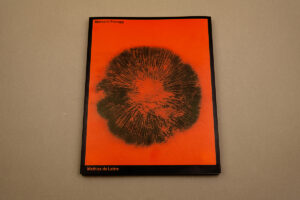YOUR CART
- No products in the cart.
Subtotal:
€ 0

SOLD OUT
Concept and photography:
Mathias de Lattre
Texts and essays:
Olivier Chambon
Remi Coignet
Jacques Mabit
Vincent Verroust
Mathias de Lattre
Text editing:
Daisy Hildyard
Translations:
Frederique Le Douarin
Dominique Eustache
Design:
Carel Fransen
Lithography:
Marc Gijzen
Production:
Jos Morree (Fine Books)
Print:
Wilco Art Books (NL)
Binding:
Patist (NL)
Mathias de Lattre (FR) developed an interest in natural psychedelics, in particular hallucinogenic mushrooms. Since ten years he had the intuition that they might constitute an alternative to the psychiatric treatment of his mother. She was diagnosed with bipolar disorder twenty years ago, and the drugs prescribed to her paradoxically heavily degraded her health.
His research on psilocybin, a naturally occurring hallucinogen produced by around 180 species of fungus, led him through prehistoric times, mycology and medicine. From the painted caves in Southern France and traditional medicinal practices in the jungle of Peru, to the scientists researching psilocybin in London and Zürich, Mother’s Therapy unites science and humanity. With texts and images the book provides context to the psilocybin-based cure given to his mother — apparently with some success. No militancy, he is simply submitting the relevant material to the record.
Mathias de Lattre lives and works in Paris. As the valedictorian graduate from the Icart-Photo school in 2012, he started his career making portraits for the press. He then gradually shifted to still life, especially for the luxury industry, and teaches photography at various American universities. His personal portraiture and landscape projects have been exhibited in Paris and Brussels and his work published in numerous magazines. Mother’s Therapy is de Lattre’s first published photo book.
“De Lattre leads us on a journey through thousands of years of entwined history and medicine, from theories about early beliefs and culture and their inter-relationship with some of the hundreds of naturally growing hallucinogenic plants, through to contemporary medical efforts to better understand the potential benefits of these substances, and the tension between this and the strict regulation of hallucinogens in many countries.” (c4 Journal)